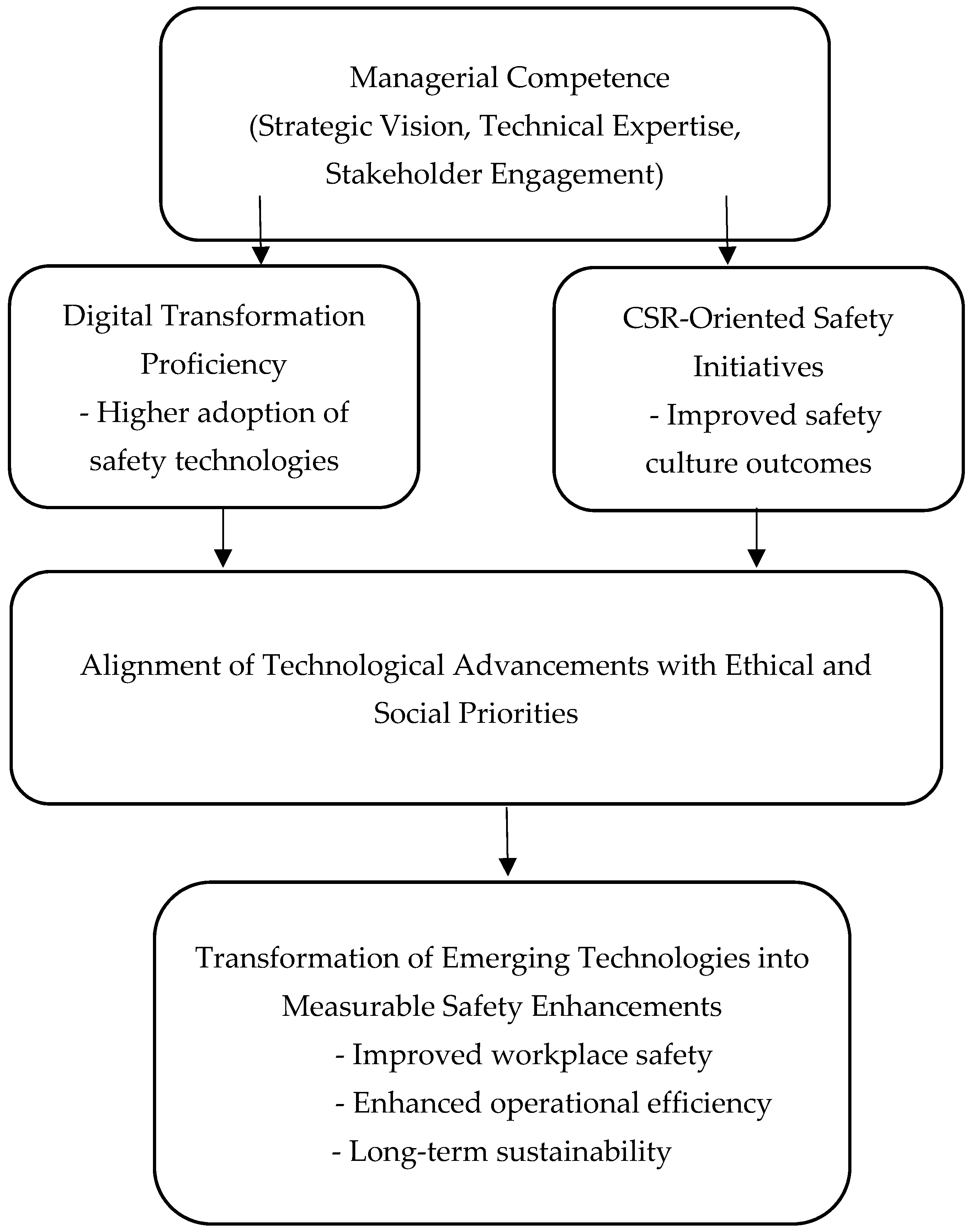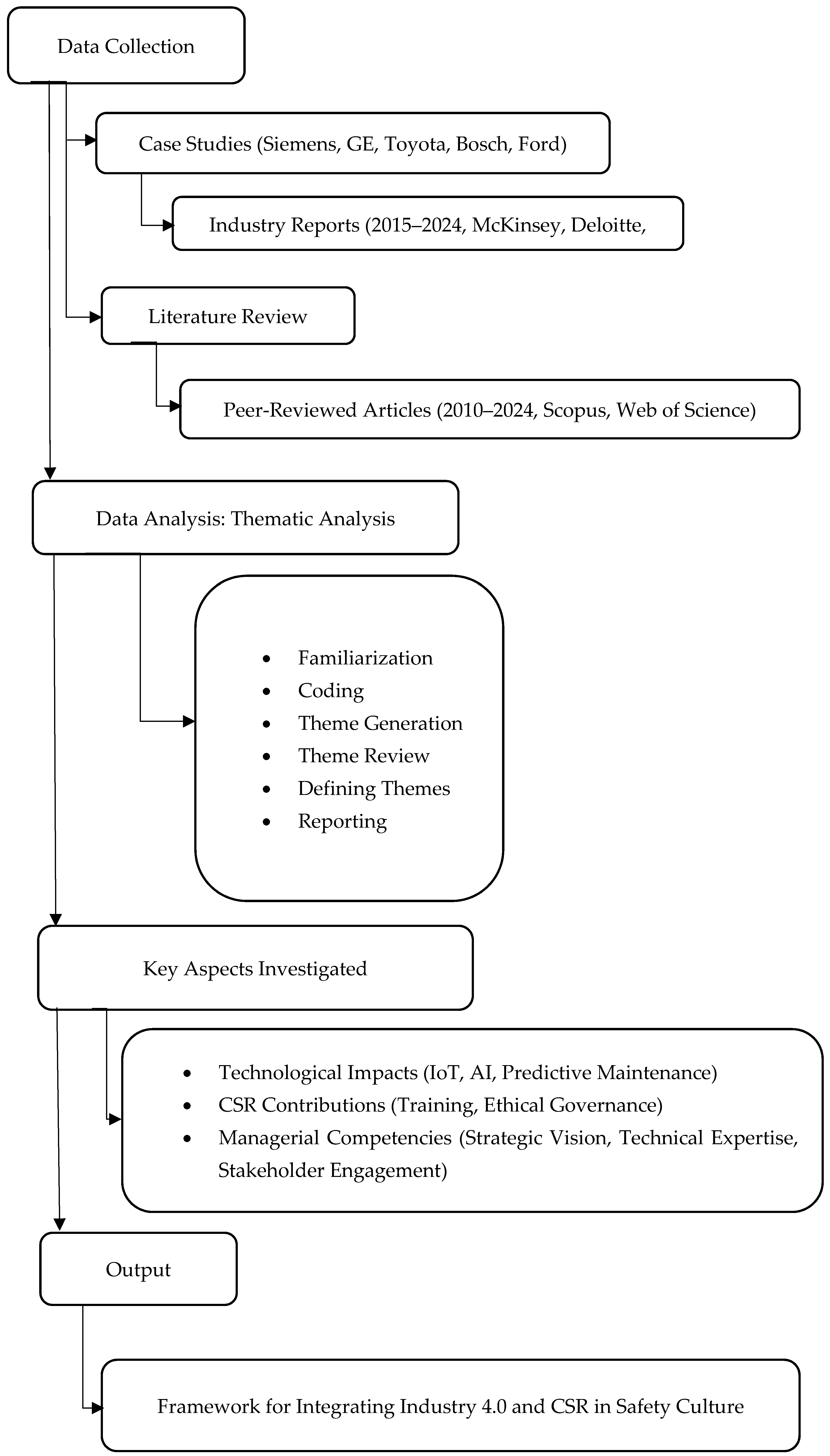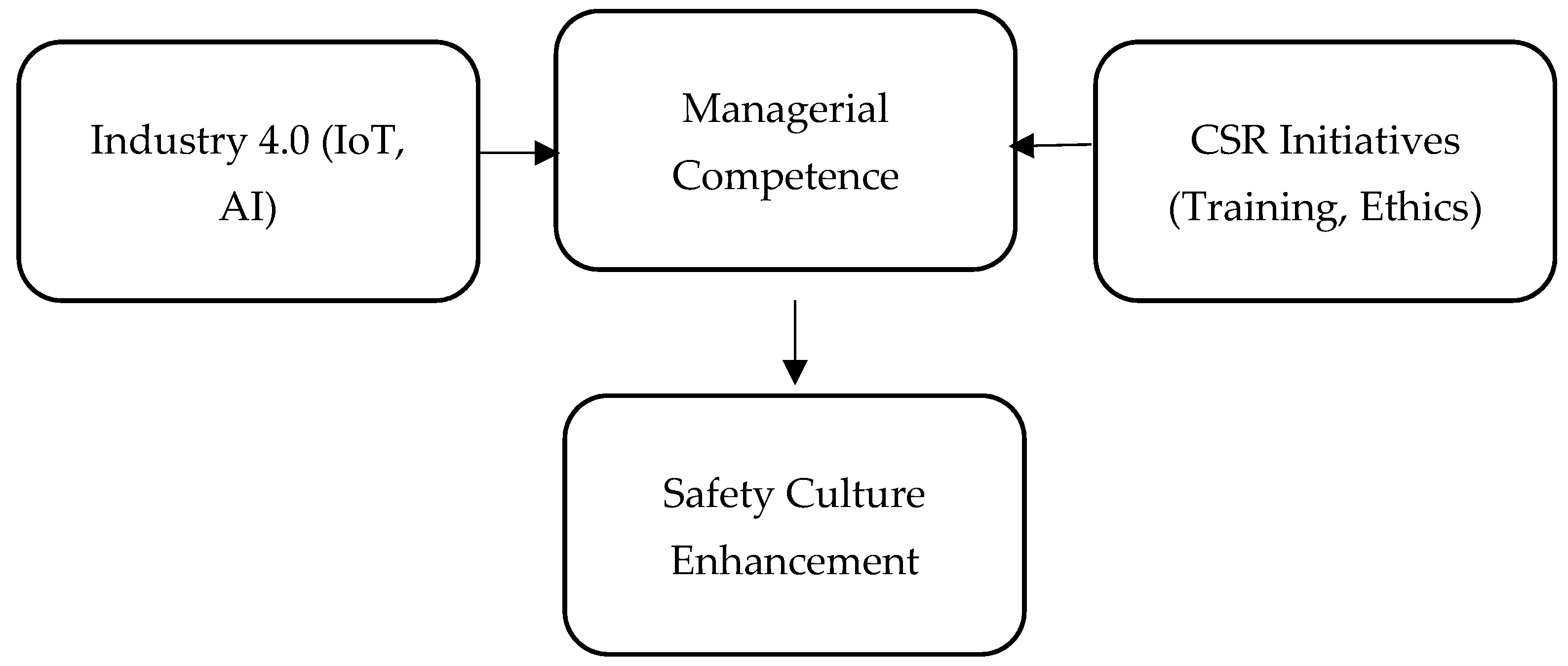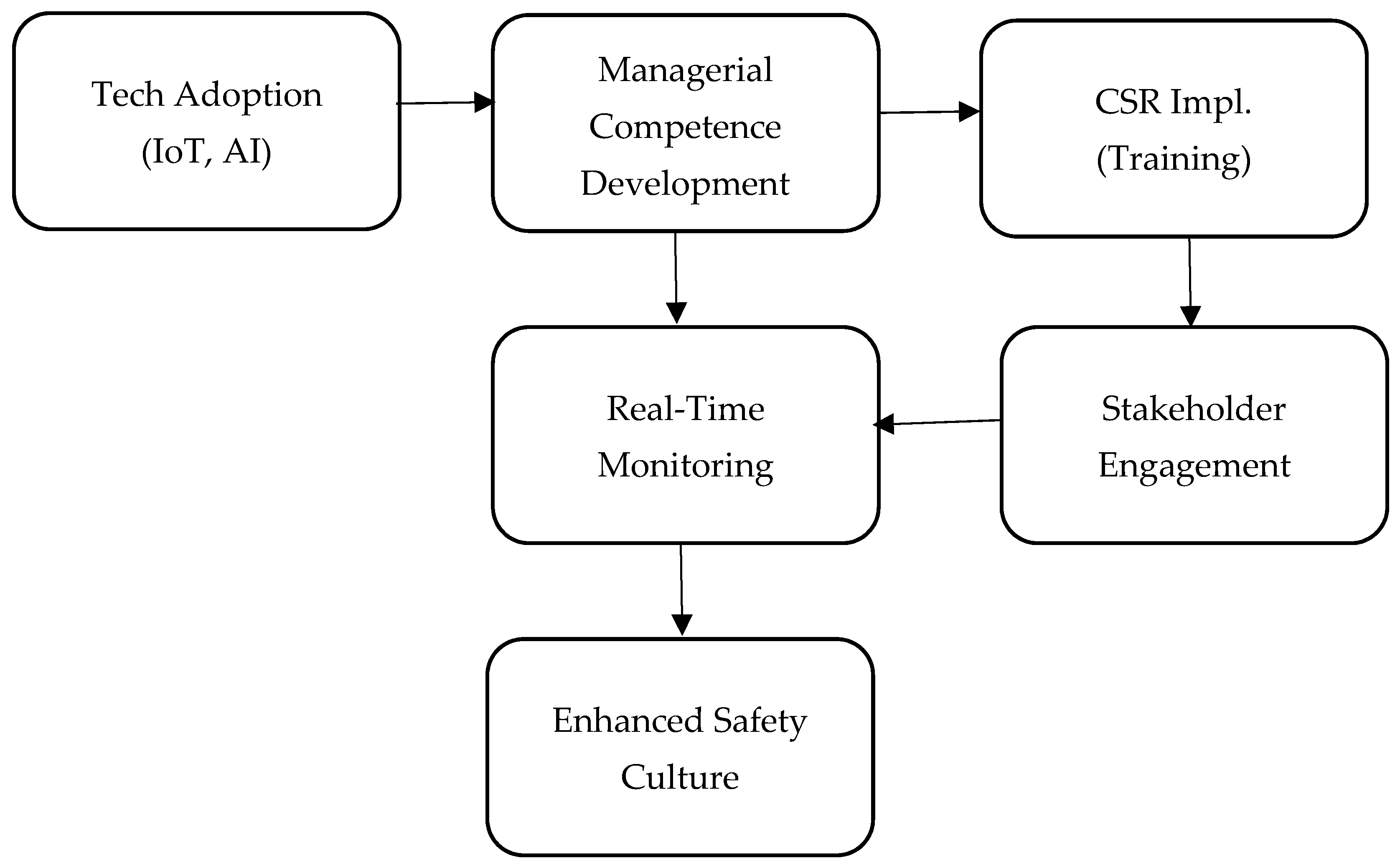Managerial Competence in Integrating Industry 4.0 with Corporate Social Responsibility for Enhanced Safety Culture in Manufacturing
Abstract
1. Introduction
2. Literature Review
2.1. Industry 4.0 and Its Impact on Manufacturing
2.2. Corporate Social Responsibility (CSR) in Manufacturing
2.3. Safety Culture in Manufacturing
2.4. The Role of Managerial Competence
2.5. Figures Illustrating the Role of Managerial Competence in Integrating Industry 4.0 with CSR
3. Methods
3.1. Research Design
3.2. Data Collection and Analysis
- Case Studies: Case studies were sourced from industry reports (2015–2024) by McKinsey, Deloitte, and PwC focusing on Siemens, General Electric, Toyota, Bosch, and Ford. These firms were selected based on their leadership in Industry 4.0 adoption and CSR integration, as evidenced by their consistent inclusion in the Dow Jones Sustainability Index (2020–2023) and documented advancements in safety culture [55]. The selection criteria prioritized firms with global operations, diverse manufacturing sectors (automotive, electronics, and industrial), and publicly available data on safety and technology integration. Other firms were excluded if they lacked sufficient industry report coverage or did not meet sustainability leadership criteria, ensuring a focused and representative sample. Reports by McKinsey, Deloitte, and PwC were chosen for their reputational rigor, comprehensive data on Industry 4.0 and CSR, and consistent coverage of the selected firms [56].
- Literature Review: Peer-reviewed articles (2010–2024) from Scopus and Web of Science, which were identified using keywords like “Industry 4.0”, “CSR”, “safety culture”, and “managerial competence”, were used in the literature review.
- Familiarization: Reading and annotating data to understand the content and context.
- Coding: Assigning codes to data segments related to Industry 4.0, CSR, safety culture, and managerial competence.
- Theme Generation: Grouping codes into themes, such as “technological contributions”, “CSR-driven training”, and “managerial competencies”.
- Theme Review: Refining themes to ensure coherence and relevance to the research question.
- Defining Themes: Naming and defining themes, e.g., “Strategic Vision”, that align safety with organizational goals.
- Reporting: Synthesizing findings into a narrative supported by evidence from case studies and literature.
4. Results
4.1. Impact of Industry 4.0 and CSR Integration
Technological Contributions
4.2. Role of Managerial Competence as the Cornerstone of Integration
- Strategic Vision: Effective managers align safety initiatives with broader organizational objectives. Siemens’ 2023 Sustainability Report links safety improvements to a 15% increase in employee satisfaction since 2020, demonstrating the impact of a well-integrated strategy [78].
- Technical Proficiency: A deep understanding of Industry 4.0 tools, fostered through training programs since 2015, enables managers to optimize IoT and AI implementation. Research by Bharadwaj et al. (2013), which was last updated by the Harvard Business Review (2023), indicates a 25% higher adoption rate of safety technologies under skilled managerial leadership [47,79].
- Stakeholder Engagement: Active collaboration with employees and regulatory bodies enhances safety program participation. ILO’s 2024 Surveys reveal a 15% increase in workforce involvement in safety initiatives since 2021, reflecting the role of effective engagement in fostering a collective commitment to workplace safety [34].
4.3. Measurable Outcomes
5. Discussion
- Investing in advanced technologies to enhance workplace safety.
- Aligning CSR initiatives with safety objectives to foster a culture of proactive risk management.
- Strengthening managerial competencies through targeted training programs.
6. Conclusions
Funding
Institutional Review Board Statement
Informed Consent Statement
Data Availability Statement
Acknowledgments
Conflicts of Interest
Abbreviations
| AI | Artificial Intelligence |
| CSR | Corporate Social Responsibility |
| EU-OSHA | European Agency for Safety and Health at Work |
| GRI | Global Reporting Initiative |
| ILO | International Labor Organization |
| IoT | Internet of Things |
| OSHA | Occupational Safety and Health Administration |
| SDGs | Sustainable Development Goals |
| VR | Virtual Reality |
References
- Kiehne, J.; Olaru, M. Implementing Industrie 4.0 Strategies: Beyond Technical Innovations; Bucharest University of Economic Studies: Bucharest, Romania, 2017. [Google Scholar]
- Lasi, H.; Fettke, P.; Kemper, H.-G.; Feld, T. Industry 4.0. Bus. Inf. Syst. Eng. 2014, 6, 239–242. [Google Scholar] [CrossRef]
- Latapí Agudelo, M.A.; Jóhannsdóttir, L.; Davídsdóttir, B. A literature review of the history and evolution of corporate social responsibility. Int. J. Corp. Soc. Responsib. 2019, 4, 1. [Google Scholar] [CrossRef]
- Nwobodo-Anyadiegwu, E.N.; Sikhakhane, Z.; Lumbwe, A.K. The Integration of Industry 4.0 into Corporate Social Responsibility Projects: A Review. In Proceedings of the 2022 IEEE 28th International Conference on Engineering, Technology and Innovation (ICE/ITMC) & 31st International Association for Management of Technology (IAMOT) Joint Conference, Nancy, France, 19–23 June 2022; Available online: https://www.researchgate.net/publication/368435106 (accessed on 10 January 2025).
- European Union. Directive (EU) 2022/2464. Off. J. Eur. Union 2022, L 322, 15–80. Available online: https://eur-lex.europa.eu/eli/dir/2022/2464/oj (accessed on 14 May 2025).
- United Nations. Transforming Our World: The 2030 Agenda for Sustainable Development. 2015. Available online: https://sdgs.un.org/2030agenda (accessed on 14 May 2025).
- European Commission. Corporate Sustainability Reporting. 2023. Available online: https://finance.ec.europa.eu/regulation-and-supervision/financial-services-legislation/implementing-and-delegated-acts/corporate-sustainability-reporting-directive_en (accessed on 14 May 2025).
- Khan, M.I.; Yasmeen, T.; Khan, M.; Hadi, N.U.; Asif, M.; Farooq, M.; Al-Ghamdi, S.G. Integrating Industry 4.0 for Enhanced Sustainability. Sustain. Prod. Consum. 2025, 54, 149–189. [Google Scholar] [CrossRef]
- Xu, L.D.; Xu, E.L.; Li, L. Industry 4.0: State of the Art and Future Trends. Int. J. Prod. Res. 2018, 56, 1–22. [Google Scholar] [CrossRef]
- Zohar, D. Thirty Years of Safety Climate Research. Accid. Anal. Prev. 2010, 42, 1517–1522. [Google Scholar] [CrossRef]
- Shet, S.V.; Pereira, V. Proposed Managerial Competencies for Industry 4.0. Technol. Forecast. Soc. Change 2021, 173, 121080. [Google Scholar] [CrossRef]
- Parmar, B.; Freeman, R.E.; Harrison, J.S.; Purnell, A.C. Stakeholder Theory: The State of the Art. Acad. Manag. Ann. 2010, 3, 403–445. [Google Scholar] [CrossRef]
- Hart, S.L.; Dowell, G. A Natural-Resource-Based View of the Firm. J. Manag. 2011, 37, 1464–1479. [Google Scholar] [CrossRef]
- Kagermann, H.; Wahlster, W.; Helbig, J. Recommendations for Implementing the Strategic Initiative INDUSTRIE 4.0: Securing the Future of German Manufacturing Industry; Final Report of the Industrie 4.0 Working Group; National Academy of Science and Engineering: Munich, Germany, 2013; Available online: https://www.din.de/resource/blob/76902/e8cac883f42bf28536e7e8165993f1fd/recommendations-for-implementing-industry-4-0-data.pdf (accessed on 14 May 2025).
- Kagermann, H.; Anderl, R.; Gausemeier, J.; Schuh, G.; Wahlster, W. Industrie 4.0 in a Global Context: Strategies for Cooperating with International Partners; Kagermann, H., Anderl, R., Gausemeier, J., Schuh, G., Wahlster, W., Eds.; Herbert Utz Verlag: Munich, Germany, 2016; ISSN 2192-6174. [Google Scholar]
- Lee, J.; Bagheri, B.; Kao, H.-A. A Cyber-Physical Systems Architecture for Industry 4.0-Based Manufacturing Systems. Manuf. Lett. 2014, 3, 18–23. [Google Scholar] [CrossRef]
- McKinsey & Company. The Future of Manufacturing: Sustainability and Digital Transformation; McKinsey Insights: New York, NY, USA, 2023; Available online: https://www.mckinsey.com/capabilities/operations/our-insights/the-future-of-manufacturing (accessed on 14 May 2025).
- Lees, M.J.; Johnstone, M.C. Implementing Safety Features of Industry 4.0 Without Compromising Safety Culture. IFAC-PapersOnLine 2021, 54, 599–604. [Google Scholar] [CrossRef]
- Deloitte. 2024 Manufacturing Industry Outlook; Deloitte Insights: New York, NY, USA, 2024; Available online: https://www2.deloitte.com/us/en/insights/industry/manufacturing/manufacturing-industry-outlook.html (accessed on 3 February 2025).
- The International Journal of Advanced Manufacturing Technology. Special Issue on Precision Engineering for Advanced Manufacturing Technology. Int. J. Adv. Manuf. Technol. 2024, 130, 2101–2350. Available online: https://link.springer.com/journal/170/volumes-and-issues/130-5 (accessed on 3 February 2025).
- Ahmed, S.F.; Alam, M.S.B.; Afrin, S.; Rafa, S.J. Toward a Secure 5G-Enabled Internet of Things: A Survey on Requirements, Privacy, Security, Challenges, and Opportunities. IEEE Access 2024, 12, 13125–13145. [Google Scholar] [CrossRef]
- Urrea, C.; Kern, J. Recent Advances and Challenges in Industrial Robotics: A Systematic Review of Technological Trends and Emerging Applications. Processes 2025, 13, 832. [Google Scholar] [CrossRef]
- Fuertes, G.; Zamorano, J.; Alfaro, M.; Vargas, M.; Sabattin, J.; Duran, C.; Ternero, R.; Rivera, R. Opportunities of the Technological Trends Linked to Industry 4.0 to Achieve Sustainable Manufacturing Objectives. Sustainability 2022, 14, 11118. [Google Scholar] [CrossRef]
- Carroll, A.B.; Shabana, K.M. The Business Case for Corporate Social Responsibility: A Review of Concepts, Research, and Practice. Int. J. Manag. Rev. 2010, 12, 85–105. [Google Scholar] [CrossRef]
- Dahlsrud, A. How Corporate Social Responsibility Is Defined: An Analysis of 37 Definitions. Corp. Soc. Responsib. Environ. Manag. 2008, 15, 1–13. [Google Scholar] [CrossRef]
- KPMG. Big Shifts, Small Steps: Survey of Sustainability Reporting 2022; KPMG International, 2022. Available online: https://assets.kpmg.com/content/dam/kpmg/se/pdf/komm/2022/Global-Survey-of-Sustainability-Reporting-2022.pdf (accessed on 14 May 2025).
- Deloitte. 2021 Manufacturing Industry Outlook: Building Resilience Through Sustainability and Trust; Deloitte Insights: New York, NY, USA, 2021; Available online: https://www2.deloitte.com/content/dam/Deloitte/us/Documents/energy-resources/us-2021-manufacturing-industry-outlook.pdf (accessed on 7 January 2025).
- Zhang, Q.; Oo, B.; Lim, B.T.H. Linking Corporate Social Responsibility (CSR) Practices and Organizational Performance in the Construction Industry: A Resource Collaboration Network. Resour. Conserv. Recycl. 2022, 179, 106113. [Google Scholar] [CrossRef]
- Shinde, M. Industry 4.0—As a Technology Enabler for CSR. Turk. J. Comput. Math. Educ. (TURCOMAT) 2021, 12, 2634–2639. [Google Scholar] [CrossRef]
- European Agency for Safety and Health at Work. Annual Report 2024: Safety and Health at Work Is Everyone’s Concern. It’s Good for You. It’s Good for Business. First Findings of the Fourth European Survey of Enterprises on New and Emerging Risks (ESENER 2024); EU-OSHA: Bilbao, Spain, 2024; Available online: https://osha.europa.eu/sites/default/files/documents/ESENER-first-findings-2024_EN.pdf (accessed on 14 May 2025).
- Hale, A.R.; Hovden, J. Management and culture: The third age of safety. In Occupational Injury: Risk, Prevention and Intervention; Feyer, A., Williamson, A., Eds.; Taylor & Francis: London, UK, 1998; pp. 129–166. [Google Scholar]
- Saleem, F.; Malik, M.I. Safety Management and Safety Performance Nexus: Role of Safety Consciousness, Safety Climate, and Responsible Leadership. Int. J. Environ. Res. Public Health 2022, 19, 13686. [Google Scholar] [CrossRef]
- Fiegler-Rudol, J.; Lau, K.; Mroczek, A.; Kasperczyk, J. Exploring Human–AI Dynamics in Enhancing Workplace Health and Safety: A Narrative Review. Int. J. Environ. Res. Public Health 2025, 22, 199. [Google Scholar] [CrossRef]
- International Labour Organization. Global Survey on Workplace Safety and Industry 4.0 Integration; ILO Publications: Geneva, Switzerland, 2024; p. 37. Available online: https://www.ilo.org/sites/default/files/wcmsp5/groups/public/@ed_norm/@relconf/documents/meetingdocument/wcms_911183.pdf (accessed on 14 May 2025).
- Zhou, Z.; Irizarry, J.; Li, Q. Applying Advanced Technology to Improve Safety Management in the Construction Industry: A Literature Review. Constr. Manag. Econ. 2013, 31, 606–622. [Google Scholar] [CrossRef]
- Asamani, L. Promote Safety Culture and Enhance Safety Performance through Safety Behaviour. Eur. J. Bus. Manag. Res. 2020, 5. [Google Scholar] [CrossRef]
- Gutterman, A.S. Corporate Social Responsibility: Implementation and Integration; Sustainable Entrepreneurship Project: Oakland CA, USA, 2023. [Google Scholar]
- Ojji, S.O. Digital Transformation and Its Impact on Safety Culture During Organizational Change. Int. J. Eng. Comput. Sci. 2024, 13, 26135–26146. [Google Scholar] [CrossRef]
- Freeman, R.E.; Harrison, J.S.; Wicks, A.C.; Parmar, B.L.; de Colle, S. Stakeholder Theory: The State of the Art; Cambridge University Press: Cambridge, UK, 2010. [Google Scholar] [CrossRef]
- Cyfert, S.; Waldemar, G.; Zastempowski, M. Impact of Management Tools Supporting Industry 4.0 on the Importance of CSR during COVID-19. Generation Z. Energies 2021, 14, 1642. [Google Scholar] [CrossRef]
- Zeng, C.; Wu, Y.; Zhang, M. Corporate digital transformation and safety production performance: Empirical evidence from A-share listed companies. China J. Account. Stud. 2024, 12, 1–35. [Google Scholar] [CrossRef]
- Jiang, L.; Jingdong, Z.; Wong, Y.D. Digital technology in occupational health of manufacturing industries: A systematic literature review. SN Appl. Sci. 2024, 6, 631. [Google Scholar] [CrossRef]
- Bhamare, D.; Zolanvari, M.; Erbad, A.; Jain, R. Cybersecurity for industrial control systems: A survey. arXiv 2020, arXiv:2002.04124. [Google Scholar] [CrossRef]
- Olise, P.; Opoku, L.K.; Mensah, N. The impact of advanced safety leadership training programs on reducing workplace accidents and enhancing asset reliability in U.S. industrial sectors. Int. J. Sci. Res. Arch. 2025, 14, 025–033. [Google Scholar] [CrossRef]
- Suryadi, Y.; Dewi, N.L.Y.; Trisnawati, T.; Al-Amin. The impact of transformational leadership on organizational performance and employee motivation. Transform. J. Manaj. 2024, 2, 65–76. [Google Scholar] [CrossRef]
- Porter, M.E.; Kramer, M.R. The Big Idea: Creating Shared Value. Harv. Bus. Rev. 2011, 89, 2–17. [Google Scholar]
- Bharadwaj, A.; El Sawy, O.A.; Pavlou, P.A.; Venkatraman, N.V. Digital Business Strategy: Toward a Next Generation of Insights. MIS Q. 2013, 37, 471–482. Available online: https://papers.ssrn.com/sol3/papers.cfm?abstract_id=2742300 (accessed on 14 May 2025). [CrossRef]
- Parvu, A. Digitalization of work and its impact on worker safety and health. In Proceedings of the 17th International Conference Interdisciplinarity in Engineering, Târgu Mureș, Romania, 5–6 October 2023; Springer: Cham, Switzerland, 2024; pp. 15–28. [Google Scholar] [CrossRef]
- Harvey, J.; Bolam, H.; Gregory, D.; Erdos, G. The effectiveness of training to change safety culture and attitudes within a highly regulated environment. Pers. Rev. 2001, 30, 615–636. [Google Scholar] [CrossRef]
- Yin, R.K. Case Study Research and Applications: Design and Methods, 6th ed.; Sage Publications: Thousand Oaks, CA, USA, 2017. [Google Scholar]
- Tranfield, D.; Denyer, D.; Smart, P. Towards a methodology for developing evidence-informed management knowledge by means of systematic review. Br. J. Manag. 2003, 14, 207–222. [Google Scholar] [CrossRef]
- UNESCO. Recommendation on the Ethics of Artificial Intelligence; UNESCO: Paris, France, 2022; Available online: https://unesdoc.unesco.org/ark:/48223/pf0000381137 (accessed on 14 May 2025).
- Braun, V.; Clarke, V. Using thematic analysis in psychology. Qual. Res. Psychol. 2006, 3, 77–101. [Google Scholar] [CrossRef]
- Ghobakhloo, M. Industry 4.0, digitization, and opportunities for sustainability. J. Clean. Prod. 2019, 252, 119869. [Google Scholar] [CrossRef]
- Dow Jones Sustainability Index. 2020–2023 Annual Report; S&P Global: New York, NY, USA, 2023. [Google Scholar]
- PwC. Sustainability Report 2021; PwC: Prague, Czech Republic, 2021; Available online: https://www.pwc.com/cz/cs/assets/Sustainability-Report-2021_EN_e-verze_compressed.pdf (accessed on 14 May 2025).
- Chivaka, R. Secondary Data Analysis; Coventry University: Coventry, UK, 2018; Available online: https://www.researchgate.net/publication/327060808_secondary_data_analysis (accessed on 14 May 2025).
- Marone, M. The Leadership Imperative: Why BFSI’s Digital Transformation Is Not All About Technology; Harvard Business School Publishing: Brighton, MA, USA, 2023; Available online: https://www.harvardbusiness.org/why-bfsis-digital-transformation-is-not-all-about-technology/ (accessed on 14 May 2025).
- De Freitas, J. Why people resist embracing AI. Harv. Bus. Rev. 2025, 103, 52. Available online: https://hbr.org/2025/01/why-people-resist-embracing-ai (accessed on 14 May 2025).
- Carter, N.; Bryant-Lukosius, D.; DiCenso, A.; Blythe, J.; Neville, A.J. The use of triangulation in qualitative research. Oncol. Nurs. Forum 2014, 41, 545–547. [Google Scholar] [CrossRef]
- Henderson, S.; Segal, E.H. Visualizing qualitative data in evaluation research. New Dir. Eval. 2013, 2013, 53–71. [Google Scholar] [CrossRef]
- Aburumman, M.; Newnam, S.; Fildes, B. Evaluating the effectiveness of workplace interventions in improving safety culture: A systematic review. Saf. Sci. 2019, 115, 376–392. [Google Scholar] [CrossRef]
- El-Helaly, M. Artificial intelligence and occupational health and safety: Benefits and drawbacks. Med. Lav. 2024, 115, e2024014. [Google Scholar] [CrossRef]
- Khan, M.; Hassan, A.; Harrison, C.; Tarbert, H. CSR reporting: A review of research and agenda for future research. Manag. Res. Rev. 2020; ahead-of-print. [Google Scholar] [CrossRef]
- Deloitte. The Fourth Industrial Revolution Is Here—Are You Ready? Deloitte Insights: New York, NY, USA, 2018; Available online: https://www2.deloitte.com/content/dam/insights/us/articles/4364_Industry4-0_Are-you-ready/4364_Industry4-0_Are-you-ready_Report.pdf (accessed on 10 February 2025).
- McKinsey Global Institute. A Future That Works: Automation, Employment, and Productivity; McKinsey & Company: New York, NY, USA, 2017; Available online: https://www.mckinsey.com/~/media/mckinsey/featured%20insights/Digital%20Disruption/Harnessing%20automation%20for%20a%20future%20that%20works/MGI-A-future-that-works-Executive-summary.ashx (accessed on 30 January 2025).
- World Economic Forum. The Future of Jobs: Employment, Skills and Workforce Strategy for the Fourth Industrial Revolution. 2016. Available online: http://www3.weforum.org/docs/WEF_Future_of_Jobs.pdf (accessed on 25 January 2025).
- Schaltegger, S.; Lüdeke-Freund, F.; Hansen, E.G. Business Models for Sustainability: A Co-Evolutionary Analysis of Sustainable Entrepreneurship, Innovation, and Transformation. Organ. Environ. 2016, 29, 264–289. [Google Scholar] [CrossRef]
- Accenture. Industrial Internet of Things: Unleashing the Potential of Connected Products and Services. 2015. Available online: https://www.accenture.com/us-en/insight-industrial-internet-of-things (accessed on 10 February 2025).
- BCG. Industry 4.0: The Future of Productivity and Growth in Manufacturing; Boston Consulting Group: Boston, MA, USA, 2016; Available online: https://www.bcg.com/publications/2015/engineered_products_project_business_industry_4_future_productivity_growth_manufacturing_industries (accessed on 11 February 2025).
- Schleich, B.; Anwer, N.; Mathieu, L.; Wartzack, S. Shaping the digital twin for design and production engineering. CIRP Ann. 2017, 66, 141–144. [Google Scholar] [CrossRef]
- Deloitte. 2024 Manufacturing Outlook. 2024. Available online: https://www2.deloitte.com or https://www.dazadiba.lv/wp-content/uploads/2024/03/DI_Global-Human-Capital-Trends-2024.pdf (accessed on 14 May 2025).
- Tao, F.; Qi, Q.; Liu, A.; Kusiak, A. Data-driven smart manufacturing. J. Manuf. Syst. 2018, 48, 157–169. [Google Scholar] [CrossRef]
- McKinsey & Company. The State of AI in Early 2024: Gen AI Adoption Spikes and Starts to Generate Value. 2024. Available online: https://www.mckinsey.com/capabilities/quantumblack/our-insights/the-state-of-ai-2024 (accessed on 14 May 2025).
- McKinsey & Company. The State of AI in 2023: Generative AI’s Breakout Year. 2023. Available online: https://www.mckinsey.com/~/media/mckinsey/business%20functions/quantumblack/our%20insights/the%20state%20of%20ai%20in%202023%20generative%20ais%20breakout%20year/the-state-of-ai-in-2023-generative-ais-breakout-year_vf.pdf (accessed on 3 February 2025).
- Zheng, P.; Wang, H.; Sang, Z.; Zhong, R.Y.; Liu, Y.; Liu, C.; Mubarok, K.; Yu, S.; Xu, X. Smart manufacturing systems for Industry 4.0: Conceptual framework, scenarios, and future perspectives. Front. Mech. Eng. 2018, 13, 137–150. [Google Scholar] [CrossRef]
- World Economic Forum. The Future of Manufacturing: Opportunities to Drive Economic Growth. 2020. Available online: https://www.weforum.org/stories/2023/06/the-future-of-manufacturing-insights-from-industry-leaders-on-navigating-the-fourth-industrial-revolution/ (accessed on 2 February 2025).
- Siemens, A.G. Sustainability and Safety Report 2023: Integrated Approaches for Industrial Transformation. 2023. Available online: https://assets.new.siemens.com/siemens/assets/api/uuid:00095b96-4712-4cd1-b045-19d5df704358/sustainability-report-fy2023.pdf (accessed on 14 May 2025).
- Deloitte. Overcoming the Tech Talent Shortage Amid Transformation; Deloitte Insights: New York, NY, USA, 2023; Available online: https://www2.deloitte.com/us/en/insights/topics/talent/overcoming-the-tech-talent-shortage-amid-transformation.html (accessed on 6 February 2025).
- World Economic Forum. The Future of Manufacturing: Opportunities to Drive Economic Growth. April 2012. Available online: https://www2.deloitte.com/content/dam/Deloitte/global/Documents/Manufacturing/gx_WEF_The-Future-Manufacturing_4_20_12.pdf (accessed on 15 February 2025).
- Global Reporting Initiative. GRI Annual Sustainability Report 2022: Towards a Global Comprehensive Reporting System. 2022. Available online: https://www.globalreporting.org/media/3yfhrjrk/gri-sustainabilityreport2022-final.pdf (accessed on 14 May 2025).
- Deloitte. Increasing Consumer Privacy and Security Concerns in the Generative AI Era; Deloitte Insights: New York, NY, USA, 2024; Available online: https://www2.deloitte.com/us/en/pages/about-deloitte/articles/press-releases/increasing-consumer-privacy-and-security-concerns-in-the-generative-ai-era.html (accessed on 14 May 2025).
- Krishnamoorthy, G.; Sistla, S.M.K.; Venkatasubbu, S.; Periyasamy, V. Enhancing worker safety in manufacturing with IoT and ML. Int. J. Multidiscip. Res. 2024. [Google Scholar] [CrossRef]
- PwC. Study Into VR Training Effectiveness; PwC UK: London, UK, 2020; Available online: https://www.pwc.co.uk/issues/technology/immersive-technologies/study-into-vr-training-effectiveness.html (accessed on 15 February 2025).
- ConocoPhillips. Digital Twins: The ‘System of Systems’; ConocoPhillips: Houston, TX, USA, 2023; Available online: https://www.conocophillips.com/spiritnow/story/digital-twins-the-system-of-systems/ (accessed on 16 February 2025).
- Gregolinska, E.; Khanam, R.; Lefort, F.; Parthasarathy, P. Capturing the True Value of Industry 4.0; McKinsey & Company: New York, NY, USA, 2022; Available online: https://www.mckinsey.com/capabilities/operations/our-insights/capturing-the-true-value-of-industry-four-point-zero (accessed on 13 February 2025).
- Akki, S.; Ouddasser, A. Occupational Health and Safety in the Digital Age: A Theoretical Study of the Impact of Digital Transformation; Higher School of Technology of Fez, Sidi Mohamed Ben Abdellah University: Fez, Morocco, 2024. [Google Scholar] [CrossRef]
- Srđević, B. Evaluating the societal impact of AI: A comparative analysis of human and AI platforms using the analytic hierarchy process. AI 2025, 6, 86. [Google Scholar] [CrossRef]
- Agarwal, A.; Ojha, R. Prioritizing implications of Industry 4.0 on the sustainable development goals: A perspective from the analytic hierarchy process in manufacturing operations. J. Clean. Prod. 2024, 444, 141189. [Google Scholar] [CrossRef]
- Nugraha, M.E. Pengaruh Waktu Belajar Taruna terhadap Hasil Belajar Matematika Teknik. J. Fis. Indones. 2024, 4, 27–32. [Google Scholar] [CrossRef]
- European Agency for Safety and Health at Work (EU-OSHA). Companies in Belgium and Italy; Publications Office of the European Union: Luxembourg, 2024; ISBN 978-92-9402-344-5. Available online: https://osha.europa.eu/sites/default/files/documents/AIWM-OSH-automotive-companies-Belgium-Italy_EN.pdf (accessed on 14 May 2025).
- Badri, A.; Trudel, B.; Souissi, A.S.E. Occupational health and safety in the Industry 4.0 era: A cause for major concern? Saf. Sci. 2018, 109, 403–411. [Google Scholar] [CrossRef]
- OECD. OECD Regulatory Policy Outlook 2025; OECD Publishing: Paris, France, 2025. [Google Scholar] [CrossRef]
- Weerts, S.; Naous, D.; El Bouchikhi, M.; Clavien, C. AI Systems for Occupational Safety and Health: From Ethical Concerns to Limited Legal Solutions. In Electronic Government; Lecture Notes in Computer Science; Springer: Cham, Switzerland, 2022; pp. 499–514. [Google Scholar] [CrossRef]
- Liu, Y.; Xu, X. Industry 4.0 and Cloud Manufacturing: A Comparative Analysis. J. Manuf. Sci. Eng. 2016, 139, 034701. [Google Scholar] [CrossRef]
- World Economic Forum. Industrial Internet of Things Safety and Security Protocol. 2018. Available online: https://www3.weforum.org/docs/47498_Industrial_Internet_Things_Safety_Security_Protocol_WP-FINAL.pdf (accessed on 20 February 2025).
- Balahurovska, I. The Role of Leadership in Industry 4.0. Syst. Saf. Hum.-Tech. Facil.-Environ. 2023, 5, 66–74. [Google Scholar] [CrossRef]




| Key Metric | Improvement | Industry Focus | Technology Involved | Companies |
|---|---|---|---|---|
| Work injury rate | 32% reduction | Manufacturing | IoT sensors + AI monitoring | Deloitte, 2024 [82] |
| Safety compliance | 38% increase | Cross-industry | Wearable tech + blockchain | Krishnamoorthy et al. (2024) [83] |
| Equipment downtime | 30–50% reduction | Automotive | Predictive maintenance AI | PwC, 2020 [84] |
| Employee safety training completion | Up to 80% | Energy Sector | VR training modules | ConocoPhillips, 2023 [85] |
| Safety audit | 15% faster for basic work orders | Electronic | Digital twin technology | McKinsey, 2022 [86] |
Disclaimer/Publisher’s Note: The statements, opinions and data contained in all publications are solely those of the individual author(s) and contributor(s) and not of MDPI and/or the editor(s). MDPI and/or the editor(s) disclaim responsibility for any injury to people or property resulting from any ideas, methods, instructions or products referred to in the content. |
© 2025 by the author. Licensee MDPI, Basel, Switzerland. This article is an open access article distributed under the terms and conditions of the Creative Commons Attribution (CC BY) license (https://creativecommons.org/licenses/by/4.0/).
Share and Cite
Ihimbazwe Ndanguza, A.P. Managerial Competence in Integrating Industry 4.0 with Corporate Social Responsibility for Enhanced Safety Culture in Manufacturing. Sustainability 2025, 17, 4678. https://doi.org/10.3390/su17104678
Ihimbazwe Ndanguza AP. Managerial Competence in Integrating Industry 4.0 with Corporate Social Responsibility for Enhanced Safety Culture in Manufacturing. Sustainability. 2025; 17(10):4678. https://doi.org/10.3390/su17104678
Chicago/Turabian StyleIhimbazwe Ndanguza, Alain Patience. 2025. "Managerial Competence in Integrating Industry 4.0 with Corporate Social Responsibility for Enhanced Safety Culture in Manufacturing" Sustainability 17, no. 10: 4678. https://doi.org/10.3390/su17104678
APA StyleIhimbazwe Ndanguza, A. P. (2025). Managerial Competence in Integrating Industry 4.0 with Corporate Social Responsibility for Enhanced Safety Culture in Manufacturing. Sustainability, 17(10), 4678. https://doi.org/10.3390/su17104678


_Li.png)



